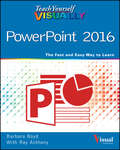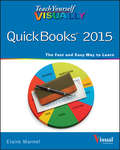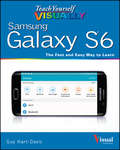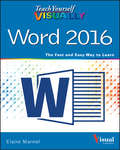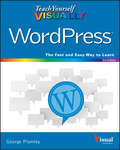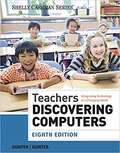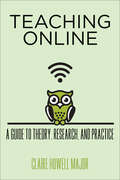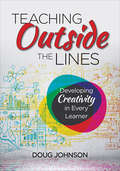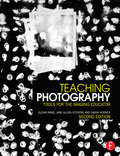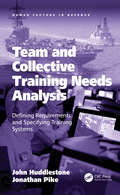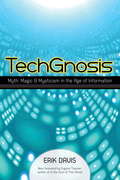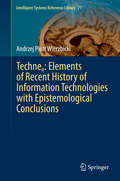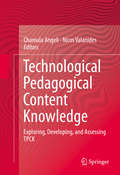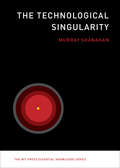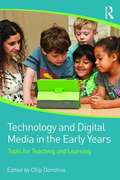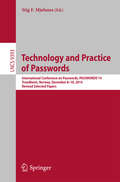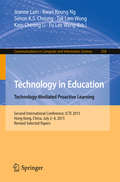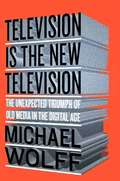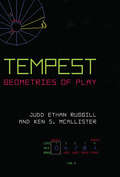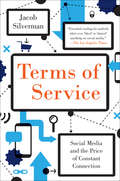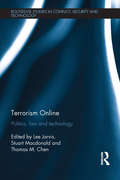- Table View
- List View
Teach Yourself VISUALLY PowerPoint 2016 (Teach Yourself VISUALLY (Tech))
by Barbara BoydThe uncomplicated PowerPoint guide designed specifically for visual learners Are you a visual learner who wants to spend more time working on your presentations than trying to figure out how to create them? Teach Yourself Visually PowerPoint offers you an effortless approach to creating winning presentations with the latest version of PowerPoint. This accessible resource features visually rich tutorials and step-by-step instructions that will help you understand all of PowerPoint's capabilities—from the most basic to the most advanced. With Teach Yourself Visually PowerPoint, you'll learn how to create slides, dress them up using templates and graphics, add sound and animation, present in a business or Internet setting, and so much more. Covering the latest additions and changes in the new version of PowerPoint, a series of easy-to-follow, full-color tutorials helps you to quickly get up and running using PowerPoint like a pro! Highly visual tutorials and step-by-step screenshots make lessons easy to follow and understand Helps you learn the basic functions of PowerPoint—and beyond Walks you through PowerPoint's latest features Demonstrates how to create memorable and captivating presentations using PowerPoint Do you prefer instructions that show you how to do something—and skip the long-winded explanations? If so, Teach Yourself Visually PowerPoint is for you.
Teach Yourself VISUALLY QuickBooks 2015
by Elaine MarmelThe visual way to master QuickBooks XIf you learn better by seeing rather than wading through confusing text, then this visual guide is for you! Teach Yourself Visually QuickBooks X gives you hundreds of succinctly captioned, step-by-step screenshots that reveal how to master QuickBooks X and get your business finances in working order. QuickBooks X is the world's most popular accounting software, but that doesn't mean it's easy to figure out on your own. In this great guide, you'll find tons of visual references that make it easy to navigate QuickBooks X. Learn how to store and process company names, addresses, and account information, track accounts payable, compile and integrate data, produce reports for tracking and analyzing financial data, and so much more--all with visual references that won't make you pull your hair out!Find out how to choose a company identity and set up your sales taxCut through the jargon and see how to edit paycheck information and track employees' time recordsCreate invoices and estimates with QuickBooks XFollow along with easy-to-decipher screenshots that make it clear how to pay bills online and print financial reportsIf you're a visual learner interested in getting your business finances in order, this see-as-you-go guide makes it easier to master QuickBooks X without the headache of trying to figure out hard-to-read text.
Teach Yourself VISUALLY Salesforce.com (Teach Yourself VISUALLY (Tech))
by Justin Davis Kristine CuringtonThe highly visual, step-by-step guide to getting the most out of Salesforce.com Teach Yourself VISUALLY Salesforce.com, 2nd Edition is your ideal guide to getting up to speed on the world's number-one on-demand customer relationship management (CRM) system. With full color screenshots and step-by-step instructions, this highly visual manual shows you everything you need to know to get the most out of Salesforce.com. You'll be walked through each step of the entire process, from choosing the right edition and customizing your service to capturing leads, inputting contacts, tracking correspondence, reviewing reports, and more. This updated edition covers the newest features and tools that make your business run more smoothly, so you can get up and running quickly. This book is your ultimate guide to optimizing Salesforce.com capabilities, helping you leverage your data into added value for your business. Choose the right Salesforce.com edition to suit your needs Master the latest and most helpful features Personalize your system for a tailor-made CRM solution Manage accounts, develop contacts, track inventory, and more
Teach Yourself VISUALLY Samsung Galaxy S6
by Guy Hart-DavisYour visual guide to unlocking the full potential of the Samsung Galaxy Teach Yourself VISUALLY Samsung Galaxy is your step-by-step, visual guide to everything your new phone has to offer. With expert guidance from veteran technology author Guy Hart-Davis, it offers clear, concise instructions and pages of full-color screenshots that make it easy to learn how to fully utilize the Galaxy's latest features and capabilities from initial set-up to staying in touch, organizing your life, playing games, watching media, and more! Configure and get your phone set up just the way you want it Text, e-mail, use social networking, and take pictures easily Get access to the Internet, maps, and navigation in a snap Download apps and sync your Galaxy S6 with other devices Your new Samsung Galaxy can streamline your life and keep you organized — all with the touch of a finger. Make the most of the experience with Teach Yourself VISUALLY Samsung Galaxy!
Teach Yourself VISUALLY Word 2016 (Teach Yourself VISUALLY (Tech))
by Elaine MarmelVisually learn the latest version of Word Are you a visual learner who prefers to see how Word works instead of hear a long-winded explanation?Teach Yourself Visually Word offers you a straightforward 'show me, don't tell me' approach to working with the newest version of the top-selling application in the Microsoft Office suite. Packed with visually rich tutorials and step-by-step instructions that will help you come to grips with all of Word's capabilities, this accessible resource will quickly and easily get you up and running on using the world's most widely used word processing program. With Teach Yourself Visually Word, you'll learn how to perform dozens of tasks, including how to set up and format documents and text in Word; work with diagrams, charts, and pictures; use Mail Merge; post documents online; and much more. Covering the newest additions and changes to the latest version of Word, a series of easy-to-follow, full-color tutorials helps you to quickly get up and running with Word like a warrior! Tutorials and step-by-step screenshots make lessons easy to follow and understand Helps you grasp the basic functions of Word—and beyond Walks you through Word's new features Demonstrates how to set up, format, and edit Word documents If you're new to the world of Word and want a highly visual roadmap to help you put it to use for you, Teach Yourself Visually Word has you covered.
Teach Yourself VISUALLY WordPress
by George PlumleyClear the "blog fog" with this complete visual guide to the WordPress platform Teach Yourself VISUALLY WordPress, 3rd Edition introduces you to the exciting possibilities of one of the world's most popular blogging platforms, and shows you how to build your blog from idea to execution. This edition has been updated to reflect the changes and new features of WordPress, and includes coverage of mobile blogging solutions that allow you to post on the go. Richly illustrated with screenshots and examples from the author's own WordPress blogs, this highly visual guide walks you through the setup and creation process step by step, and offers expert tips and tricks every step of the way. From installing WordPress and choosing a theme to custom site editing and self-hosting, this book provides the answers you need and helps you get organized and published quickly.This is your essential guide to getting the most out of WordPress, from basic setup to advanced mobile features. Customize your site with plug-ins, themes, and personalized editing Blog whenever, wherever, with mobile blogging solutions Buy your domain, choose a hosting service, and set up the admin stuff Learn the best practices that result in engaging, dynamic websites Whether you're promoting a business, building a personal brand, or just have something to say, this is your no-nonsense guide to building your blog.
Teachers Discovering Computers: Integrating Technology in a Changing World
by Glenda A. Gunter Randolph E. GunterTEACHERS DISCOVERING COMPUTERS: INTEGRATING TECHNOLOGY IN A CHANGING WORLD, EIGHTH EDITION introduces future educators to technology and digital media in order to help them successfully teach the current generation of digital students.
Teaching and Digital Technologies
by Michael Henderson Geoff RomeoTeaching and Digital Technologies: Big Issues and Critical Questions helps both pre-service and in-service teachers to critically question and evaluate the reasons for using digital technology in the classroom. Unlike other resources that show how to use specific technologies – and quickly become outdated, this text empowers the reader to understand why they should (or should not) use digital technologies, when it is appropriate (or not), and the implications arising from these decisions. The text directly engages with policy, the Australian Curriculum, pedagogy, learning and wider issues of equity, access, generational stereotypes and professional learning. The contributors to the book are notable figures from across a broad range of Australian universities, giving the text a unique relevance to Australian education while retaining its universal appeal. Teaching and Digital Technologies is an essential contemporary resource for early childhood, primary and secondary pre-service and in-service teachers in both local and international education environments.
Teaching Online: A Guide to Theory, Research, and Practice (Tech.edu: A Hopkins Series on Education and Technology)
by Claire Howell MajorDemystifies online teaching for both enthusiastic and wary educators and helps faculty who teach online do their best work as digital instructors.It is difficult to imagine a college class today that does not include some online component—whether a simple posting of a syllabus to course management software, the use of social media for communication, or a full-blown course offering through a MOOC platform. In Teaching Online, Claire Howell Major describes for college faculty the changes that accompany use of such technologies and offers real-world strategies for surmounting digital teaching challenges.Teaching with these evolving media requires instructors to alter the ways in which they conceive of and do their work, according to Major. They must frequently update their knowledge of learning, teaching, and media, and they need to develop new forms of instruction, revise and reconceptualize classroom materials, and refresh their communication patterns. Faculty teaching online must also reconsider the student experience and determine what changes for students ultimately mean for their own work and for their institutions. Teaching Online presents instructors with a thoughtful synthesis of educational theory, research, and practice as well as a review of strategies for managing the instructional changes involved in teaching online. In addition, this book presents examples of best practices from successful online instructors as well as cutting-edge ideas from leading scholars and educational technologists. Faculty members, researchers, instructional designers, students, administrators, and policy makers who engage with online learning will find this book an invaluable resource.
Teaching Outside the Lines: Developing Creativity in Every Learner
by Douglas A. JohnsonMake Creativity The Center Of The Curriculum! In our fast-changing world, the ability to think independently and innovatively is no longer a “nice extra”—it’s a survival skill. This book delivers surefire strategies for equipping learners across all grades and subjects with the motivation and critical thinking skills to thrive in our high-tech future. Content includes: Why “one right answer” instruction paradigms discourage critical thinking and risk-taking Why merely using the latest technology class does not equate to teaching creatively Projects and prompts that ask the question “So what does this mean in the classroom today?”
Teaching Outside the Lines: Developing Creativity in Every Learner
by Douglas A. JohnsonMake Creativity The Center Of The Curriculum! In our fast-changing world, the ability to think independently and innovatively is no longer a “nice extra”—it’s a survival skill. This book delivers surefire strategies for equipping learners across all grades and subjects with the motivation and critical thinking skills to thrive in our high-tech future. Content includes: Why “one right answer” instruction paradigms discourage critical thinking and risk-taking Why merely using the latest technology class does not equate to teaching creatively Projects and prompts that ask the question “So what does this mean in the classroom today?”
Teaching Photography: Tools for the Imaging Educator (Photography Educators Series)
by Glenn Rand Jane Alden Stevens Garin HornerThe photographic community is rife with talented and creative practitioners and artists. But making great photographs does not always translate into an ability to teach effectively. This new edition of Teaching Photography approaches photographic education from a point of view that stresses the how and why of the education. It includes the resources that will inspire new and seasoned teachers to help students expand their technical and aesthetic abilities and techniques, as well as their visual literacy and the way photography fits into the wider world. Fully updated to include the online/hybrid classroom environment, collaborative learning, rubrics, and using digital technology, plus techniques for inspiring conversations and critiques.
Team and Collective Training Needs Analysis: Defining Requirements and Specifying Training Systems (Human Factors in Defence)
by John Huddlestone Jonathan PikeMilitary capability is delivered operationally at a team and collective level, be it a unit as small as a squad or section, or as large as a maritime task group. Modern military forces are required to deal with a potentially wide range of missions frequently involving multiple alliance partners, within a geopolitical environment which can seem to change rapidly. Individual performance, while being important, is not the primary determinant of mission success - force integration, interoperability, adaptability and teamwork are key factors. Team and collective training which fully addresses these factors is fundamental to the development and delivery of military capability. As a consequence, the requirement to determine training requirements and specify effective systems for the delivery of team and collective training is critical to operational success. Training Needs Analysis (also known as Front End Analysis), is a well-established methodology for analysing training requirements and specifying training solutions used extensively by the UK and its NATO partners. However, the analytical techniques employed are optimised for individual training, with little guidance being offered on its application in the team and collective context. Team and Collective Training Needs Analysis (TCTNA) has been developed to close this methodological gap. It addresses the issues of the relationship of individual and team tasks, teamwork, command and control, task and training environments, scenario definition, instructional strategy, team training approaches, instructional functions, and wide-ranging organisational and procurement considerations. Part One of the book develops an integrated set of models which underpin the analytical approach presented in Part Two. Worked examples and case studies illustrate the application of the approach. Between 2005 and 2015 the authors worked on numerous training-related research projects at Cranfield University and Coventry University for the Human Factors Integration Defence Technology Centre and the Defence Human Capability Science and Technology Centre on behalf of the Defence Science and Technology Laboratory, UK Ministry of Defence.
TechGnosis
by Eugene Thacker Erik DavisHow does our fascination with technology intersect with the religious imagination? In TechGnosis--a cult classic now updated and reissued with a new afterword--Erik Davis argues that while the realms of the digital and the spiritual may seem worlds apart, esoteric and religious impulses have in fact always permeated (and sometimes inspired) technological communication. Davis uncovers startling connections between such seemingly disparate topics as electricity and alchemy; online roleplaying games and religious and occult practices; virtual reality and gnostic mythology; programming languages and Kabbalah. The final chapters address the apocalyptic dreams that haunt technology, providing vital historical context as well as new ways to think about a future defined by the mutant intermingling of mind and machine, nightmare and fantasy.From the Trade Paperback edition.ology; programming languages and channeled texts. The final chapters address both apocalyptic and utopian dreams of the future of technology, providing historical context as well as new models for how to think and feel our way through an amazing, confusing, and disturbing time. This new edition features a foreword by Eugene Thacker as well as a new afterword reflecting on surveillance; the current tech bubble; the growth of superheroes, horror, and other "uncanny cultures" online; the growing backlash against technology; and the need to revitalize the cosmic imagination.ContentsIntroduction: crossed wires I imagining technologies II the alchemical fire III the gnostic infonaut IV techgnosis, american-style V the spiritual cyborg VI a most enchanting machine VII cyberspace: the virtual craft VIII the alien call IX datapocalypse X third mind from the sun XI the path is a network Afterword: beyond the boomFrom the Trade Paperback edition.
Technen: Elements of Recent History of Information Technologies with Epistemological Conclusions
by Andrzej Piotr WierzbickiThe book expresses the conviction that the art of creating tools - Greek techne - changes its character together with the change of civilization epochs and co-determines such changes. This does not mean that tools typical for a civilization epoch determine it completely, but they change our way of perceiving and interpreting the world. There might have been many such epochs in the history of human civilization (much more than the three waves of agricultural, industrial and information civilization). This is expressed by the title Technen of the book, where n denotes a subsequent civilization epoch. During last fifty years we observed a decomposition of the old episteme (understood as a way of creating and interpreting knowledge characteristic for a given civilization epoch) of modernism, which was an episteme typical for industrial civilization. Today, the world is differently understood by the representatives of three different cultural spheres: of strict and natural sciences; of human and social sciences (especially by their part inclined towards postmodernism) and technical sciences that have a different episteme than even that of strict and natural sciences. Thus, we observe today not two cultures, but three different episteme. The book consists of four parts. First contains basic epistemological observations, second is devoted to selected elements of recent history of information technologies, third contains more detailed epistemological and general discussions, fourth specifies conclusions. The book is written from the cognitive perspective of technical sciences, with a full awareness - and discussion - of its differences from the cognitive perspective of strict sciences or human and social sciences. The main thesis of the book is that informational revolution will probably lead to a formation of a new episteme. The book includes discussions of many issues related to such general perspective, such as what is technology proper; what is intuition from a perspective of technology and of evolutionary naturalism; what are the reasons for and how large are the delays between a fundamental invention and its broad social utilization; what is the fundamental logical error (using paradoxes that are not real, only apparent) of the tradition of sceptical philosophy; what are rational foundations and examples of emergence of order out of chaos; whether civilization development based on two positive feedbacks between science, technology and the market might lead inevitably to a self-destruction of human civilization; etc.
Technological Pedagogical Content Knowledge
by Charoula Angeli Nicos ValanidesTechnological pedagogical content knowledge (TPCK) reflects a new direction in understanding the complex interactions among content, pedagogy, learners and technology that can result in successful integration of multiple technologies in teaching and learning. The purpose of this edited volume is to introduce TPCK as a conceptual framework for grounding research in the area of teachers' cognitive understanding of the interactions of technology with content, pedagogy and learner conceptions. Accordingly, the contributions will constitute systematic research efforts that use TPCK to develop lines of educational technology research exemplifying current theoretical conceptions of TPCK and methodological and pedagogical approaches of how to develop and assess TPCK.
The Technological Singularity (The MIT Press Essential Knowledge series)
by Murray ShanahanThe idea of technological singularity, and what it would mean if ordinary human intelligence were enhanced or overtaken by artificial intelligence.The idea that human history is approaching a “singularity”—that ordinary humans will someday be overtaken by artificially intelligent machines or cognitively enhanced biological intelligence, or both—has moved from the realm of science fiction to serious debate. Some singularity theorists predict that if the field of artificial intelligence (AI) continues to develop at its current dizzying rate, the singularity could come about in the middle of the present century. Murray Shanahan offers an introduction to the idea of the singularity and considers the ramifications of such a potentially seismic event.Shanahan's aim is not to make predictions but rather to investigate a range of scenarios. Whether we believe that singularity is near or far, likely or impossible, apocalypse or utopia, the very idea raises crucial philosophical and pragmatic questions, forcing us to think seriously about what we want as a species. Shanahan describes technological advances in AI, both biologically inspired and engineered from scratch. Once human-level AI—theoretically possible, but difficult to accomplish—has been achieved, he explains, the transition to superintelligent AI could be very rapid. Shanahan considers what the existence of superintelligent machines could mean for such matters as personhood, responsibility, rights, and identity. Some superhuman AI agents might be created to benefit humankind; some might go rogue. (Is Siri the template, or HAL?) The singularity presents both an existential threat to humanity and an existential opportunity for humanity to transcend its limitations. Shanahan makes it clear that we need to imagine both possibilities if we want to bring about the better outcome.
Technology and Digital Media in the Early Years: Tools for Teaching and Learning
by Chip DonohueThis book provides strategies, theoretical frameworks, links to research evidence, descriptions of best practice, and resources to develop essential digital literacy knowledge, skills, and experiences for early childhood educators in the digital age.
Technology and Practice of Passwords
by Stig F. MjølsnesThis book constitutes the thoroughly refereed post-conference proceedings of the 7th International Conference on Passwords, PASSWORDS 2014, held in Trondheim, Norway, in December 2014. The 8 revised full papers presented together with 2 revised short papers were carefully reviewed and selected from 30 initial submissions. The papers are organized in topical sections on hash functions, usability, analyses and new techniques.
Technology in Education. Technology-Mediated Proactive Learning
by Jeanne Lam Kwan Keung Ng Simon K.S. Cheung Tak Lam Wong Kam Cheong Li Fu Lee WangThis bookconstitutes extended papers from the Second International Conference onTechnology in Education, ICTE 2015, held in Hong Kong, China, in July 2015. The 26 fullpapers presented in this volume were carefully reviewed and selected from 41submissions. They were organized in topical sections named: technology-enabledlearning; mobile learning and ubiquitous learning; open learning and onlinelearning; institutional strategies, policies and practices; and learningplatforms and advising systems.
Television Is the New Television
by Michael Wolff"The closer the new media future gets, the further victory appears." --Michael WolffThis is a book about what happens when the smartest people in the room decide something is inevitable, and yet it doesn't come to pass. What happens when omens have been misread, tea leaves misinterpreted, gurus embarrassed?Twenty years after the Netscape IPO, ten years after the birth of YouTube, and five years after the first iPad, the Internet has still not destroyed the giants of old media. CBS, News Corp, Disney, Comcast, Time Warner, and their peers are still alive, kicking, and making big bucks. The New York Times still earns far more from print ads than from digital ads. Super Bowl commercials are more valuable than ever. Banner ad space on Yahoo can be bought for a relative pittance.Sure, the darlings of new media--Buzzfeed, HuffPo, Politico, and many more--keep attracting ever more traffic, in some cases truly phenomenal traffic. But as Michael Wolff shows in this fascinating and sure-to-be-controversial book, their buzz and venture financing rounds are based on assumptions that were wrong from the start, and become more wrong with each passing year. The consequences of this folly are far reaching for anyone who cares about good journalism, enjoys bingeing on Netflix, works with advertising, or plans to have a role in the future of the Internet.Wolff set out to write an honest guide to the changing media landscape, based on a clear-eyed evaluation of who really makes money and how. His conclusion: the Web, social media, and various mobile platforms are not the new television. Television is the new television.We all know that Google and Facebook are thriving by selling online ads--but they're aggregators, not content creators. As major brands conclude that banner ads next to text basically don't work, the value of digital traffic to content-driven sites has plummeted, while the value of a television audience continues to rise. Even if millions now watch television on their phones via their Netflix, Hulu, and HBO GO apps, that doesn't change the balance of power. Television by any other name is the game everybody is trying to win--including outlets like The Wall Street Journal that never used to play the game at all.Drawing on his unparalleled sources in corner offices from Rockefeller Center to Beverly Hills, Wolff tells us what's really going on, which emperors have no clothes, and which supposed geniuses are due for a major fall. Whether he riles you or makes you cheer, his book will change how you think about media, technology, and the way we live now.From the Hardcover edition.
Temperature- and Supply Voltage-Independent Time References for Wireless Sensor Networks
by Valentijn De Smedt Georges Gielen Wim DehaeneThis book investigates the possible circuit solutions to overcome the temperature and supply voltage-sensitivity of fully-integrated time references for ultra-low-power communication in wireless sensor networks. The authors provide an elaborate theoretical introduction and literature study to enable full understanding of the design challenges and shortcomings of current oscillator implementations. Furthermore, a closer look to the short-term as well as the long-term frequency stability of integrated oscillators is taken. Next, a design strategy is developed and applied to 5 different oscillator topologies and 1 sensor interface. All 6 implementations are subject to an elaborate study of frequency stability, phase noise and power consumption. In the final chapter all blocks are compared to the state of the art.
Tempest: Geometries Of Play
by Judd Ethan Ruggill Ken S. McallisterAtari's 1981 arcade hit Tempest was a "tube shooter" built around glowing, vector-based geometric shapes. Among its many important contributions to both game and cultural history, Tempest was one of the first commercial titles to allow players to choose the game's initial play difficulty (a system Atari dubbed "SkillStep"), a feature that has since became standard for games of all types. Tempest was also one of the most aesthetically impactful games of the twentieth century, lending its crisp, vector aesthetic to many subsequent movies, television shows, and video games. In this book, Ruggill and McAllister enumerate and analyze Tempest's landmark qualities, exploring the game's aesthetics, development context, and connections to and impact on video game history and culture. By describing the game in technical, historical, and ludic detail, they unpack the game's latent and manifest audio-visual iconography and the ideological meanings this iconography evokes.
Terms of Service
by Jacob SilvermanSocial networking has grown into a staple of modern society, but its continued evolution is becoming increasingly detrimental to our lives. Shifts in communication and privacy are affecting us more than we realize or understand. Terms of Service crystalizes this current moment in technology and contemplates its implications: the identity-validating pleasures and perils of online visibility; our newly adopted view of daily life through the lens of what is share-worthy; and the surveillance state operated by social media platforms--Facebook, Google, Twitter, and others--to mine our personal data for advertising revenue, an invasion of our lives that is as pervasive as government spying.Jacob Silverman calls for social media users to take back ownership of their digital selves from the Silicon Valley corporations who claim to know what's best for them. Integrating politics, sociology, national security, pop culture, and technology, he reveals the surprising conformity at the heart of Internet culture--explaining how social media companies engineer their products to encourage shallow engagement and discourage dissent. Reflecting on the collapsed barriers between our private and public lives, Silverman brings into focus the inner conflict we feel when deciding what to share and what to "like," and explains how we can take the steps we need to free ourselves from its grip.
Terrorism Online: Politics, Law and Technology (Routledge Studies in Conflict, Security and Technology)
by Lee Jarvis Stuart MacDonald Thomas M. ChenThis book investigates the intersection of terrorism, digital technologies and cyberspace. The evolving field of cyber-terrorism research is dominated by single-perspective, technological, political, or sociological texts. In contrast, Terrorism Online uses a multi-disciplinary framework to provide a broader introduction to debates and developments that have largely been conducted in isolation. Drawing together key academics from a range of disciplinary fields, including Computer Science, Engineering, Social Psychology, International Relations, Law and Politics, the volume focuses on three broad themes: 1) how – and why – do terrorists engage with the Internet, digital technologies and cyberspace?; 2) what threat do these various activities pose, and to whom?; 3) how might these activities be prevented, deterred or addressed? Exploring these themes, the book engages with a range of contemporary case studies and different forms of terrorism: from lone-actor terrorists and protest activities associated with ‘hacktivist’ groups to state-based terrorism. Through the book’s engagement with questions of law, politics, technology and beyond, the volume offers a holistic approach to cyberterrorism which provides a unique and invaluable contribution to this subject matter. This book will be of great interest to students of cybersecurity, security studies, terrorism and International Relations.
